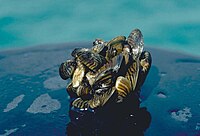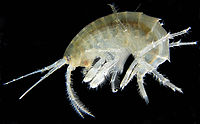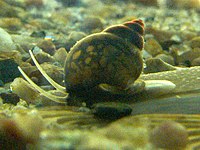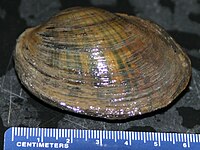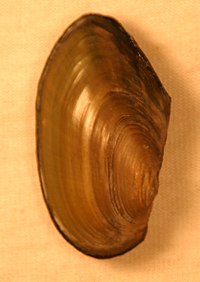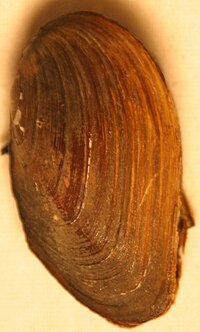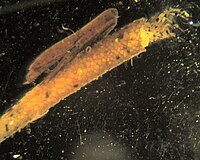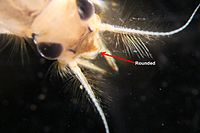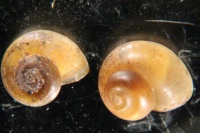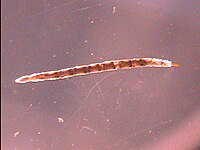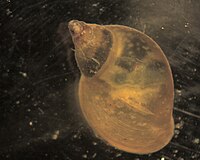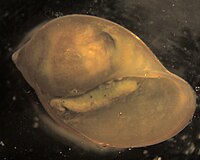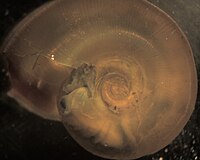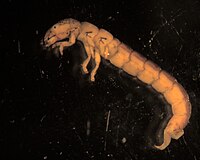Vermont EPSCoR's Streams Project; A Teacher Collaboration on WikiEducator
Openly shared content, practices, and developing resources from Vermont EPSCoR's Streams Project. Join this collaboration and make a difference!
 Missisquoi Bay |
|---|
|
| Basin: | Saint Lawrence |
| State or Province: | Vermont |
| Country: | Canada and USA |
| Latitude: | 45.023796 |
| Longitude: | -73.136044 |
| School: | Saint Michael's College |
This site is designed to facilitate identification of benthic macroinvertebrates from Missisquoi Bay in Lake Champlain.
Chironomidae
- Order
- Diptera
- Family
- Chironomidae
- Common name
- Nonbiting midge
- Tied fly
- Griffith's Gnat
Midge larvae tend to be the most common macroinvertebrate at our sites. As with other Diptera, there are no true jointed legs. Chironomidae do have a pair of prolegs at each end and preserved individuals tend to curl into a 'C'. Identification past family requires slide-mounted heads. We have seen philopotamid caddisflies misidentified with the chironomids and we suspect that that happens when samples are being sorted from trays. Under a microscope, six prominent legs can be seen on members of the caddisfly family Philopotamidae.
More information on Philopotamidae.
Dreissena polymorpha
- Order
- Veneroida
- Family
- Dreisseniidae
- Genus
- Dreissena
- Common name
- Zebra mussel
Because zebra mussels are invasive exotic species, it is important to ensure that they are not inadvertently moved to other water bodies. Follow the most current DEC guidelines on safe practices when dealing with invasive species. The guidelines currently (last checked Nov 2009) include drying equipment for at least 5 days prior to using elsewhere.
Gammaridae
- Order
- Amphipoda
- Family
- Gammaridae
The body of this scud is flattened side-to-side. It has seven pairs of walking legs and two pairs of antennae. On third third antennal segment, there is a segmented flagellum.
Images of the body flattened side-to-side, and the segmented flagellum.
Bithyniidae
- Order
- Neotaenioglossa
- Family
- Bithyniidae
- Genus
- Bithynia
- Common name
- Faucet Snail
Members of the family Bithyniidae belong in the class of Gastropoda. These snails are characterized by their horn-shaped shells with a shell calcareous lid, or operculum. The operculum contains concentric rings although it may be necessary to scrape through algae and/or dry the snail to see them. The shell typically has 4 or 5 whorls and the total shell height is less than 15mm. We have found this family only in Lake Champlain.
Bithynia tentaculata is an exotic species in North America and has been collected here since the 1800s.
Images of the concentric rings and the shell height.
More information on the class Gastropoda.
Lampsilis radiata
- Order
- Unionoida
- Family
- Unionidae
- Genus
- Lampsilis
Lampsilis radiata or the eastern lampmussel occurs commonly in Lake Champlain but are suffering mortality because of the invasive zebra mussels. They range in color from yellowish green when young to brownish black when mature. Prominent dark greenish rays or stripes radiate out from the center to the margins of the shell. They can exceed 15cm in length. Internal shell surface is white, pink, or salmon colored.
Pyganodon cataracta
- Order
- Unionoida
- Family
- Unionoidae
- Genus
- Pyganodon
Characteristics:
5 - 13 cm long with a brown/greenish/bright gold shell. The nacre or internal shell surface is silver white with blue or yellowish tones.
Click here to see the color of the internal shell surface
Lampsilis ovata
- Order
- Unionoida
- Family
- Unionoidae
- Genus
- Lampsilis
Characteristics: approximately 12 cm long inches with yellowish/brownish yellow shell. The shells are wide, and have dark rays. The nacre or the internal shell surface is whiteish.
Image of the internal shell surface.
Leptoceridae
- Order
- Trichoptera
- Family
- Leptoceridae
- Tied fly
- White Miller, LaFontaine Dancing Caddis
At least two genera from this family are common in Lake Champlain. The species in the genus Nectopsyche that we have found is very long (2.5 cm) and slender. Oecetis cases from our samples are shaped like cornucopia.
Hexagenia
- Order
- Ephemeroptera
- Family
- Ephemeridae
- Genus
- Hexagenia
Hexagenia are by far the most common representative of the Ephemeridae that we collect. There is a forward extension of the head that has a rounded edge as shown in the photograph to the right. Nymphs with a forked extension are in the genus Ephemera.
Ephemeridae
- Order
- Ephemeroptera
- Family
- Ephemeridae
- Genus
- Ephemera
- Common name
- The Coffin Fly
- Tied fly
- Dette Coffin Fly
Burrowing mayflies are common in soft sediments in Lake Champlain and also occur in muddy stream pools and in larger rivers. Nymphs have prominent forward-pointing tusks that curve upwards. The fore tibia have lobes or expanded areas that facilitate burrowing. Two genera are common in and around Vermont:
Ephemera and
Hexagenia;
Litobrancha also occurs.
Images of the tusks, and the fore tibia.
More information on Hexagenia.
Pisidiidae
- Order
- Veneroida
- Family
- Pisidiidae
Fingernail clams are the most common small clams that we find in Vermont rivers. Larger bivalves should not be sampled because they may belong to a protected species. Under no circumstances should clams be moved from one river site to another.
Valvata
- Order
- Heterostropha
- Family
- Valvatidae
- Genus
- Valvata
The species from this genus that we find has relatively low spires. All members of the genus are right-handed snails and have a spiral opercular pattern.
Valvata tricarinata have three prominent ridges that are absent from the also very common
V. piscinalis (the right most snail in the image of the genus). Click here to see the
low spires, and the
three prominent ridges
{{InsectSection
|name=Phylocentropus
|order=Trichoptera
|family=Dipseudopsidae
|genus=Phylocentropus
|image=File:Phylocentropus.jpg
|link=
|text=Phylocentropus larvae build forked tunnels in soft sediments. We frequently collect them in Mississquoi Bay. Their tibia are uniquely flattened and the claws are very much reduced by comparison to other caddisflies. They also have a unique pointed mouth part that sticks straight forward out of the underside of the head.
Images of the reduced claws and unique pointed mouth part.
Ceratopogonidae
- Order
- Diptera
- Family
- Ceratopogonidae
- Common name
- biting midges
Members of this family look like very straight Chironomidae. They are very long and thin with a distinct head capsule and no prolegs. Some in the lab call them 'bamboo sticks' with eyes.
Image of the distinct head capsule.
==Everything above this comment has been found in samples and everything below occurs in Lake Champlain but not yet seen in our Missisquoi samples.
Lymnaeidae
Members of the family Lymnaeidae belong in the class of Gastropoda. Members contain a single, coiled shell with a right-handed spiral. Differing from those of Planorbidae, members of Lymnaeidae have a larger opening. Respiration in these snails are through lung-like structures. Preferred habitats include those with slow streaming waters and heavy vegetation. These right handed snails are somewhat less tolerant of water pollution than our other common snails.
Images of the family Lymnaeidae and the class Gastropoda.
Physidae
Members of the family Physidae belong in the class of Gastropoda. Members contain a single, coiled shell with a left handed spiral going counterclockwise. Belonging to the family of aquatic pulmonates, members breathe air using a structure similar to a lung.
Images of the family Physidae, the class of Gastropodaand a shell with a left-handed spiral.
Planorbidae
- Order
- Basommatophora
- Family
- Planorbidae
- Common name
- Ram's horn snail
Members of the family Planorbidae belong in the class of Gastropoda. The shell of many Planorbidae is flat and dextral, or right-turned. Belonging to the largest family of aquatic pulmonates, members breathe air using a structure similar to a lung.
Images of the family Planorbidaeand class Gastropoda.
Polycentropus
- Order
- Trichoptera
- Family
- Polycentropodidae
- Genus
- Polycentropus
The most common genus we encounter is
Polycentropus. These caseless caddisflies frequently have speckled or freckled heads. The anal proleg typically has a prominent black X, although it can in some specimens appear to be a little faded. They are common at Oakledge Park in Lake Champlain, where we also find an additional genus in the same family:
Nyctiophylax.
Click to see the speckled or freckled heads or the prominent black X.


